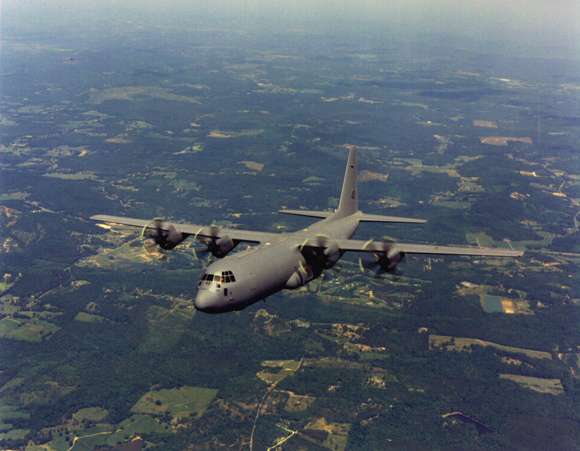| Manufacturer: Lockheed Martin |
Country of Origin: USA |
Model: C130 Hercules

Information:
First named "Hercules" after myth, the C-130 has become a true, real-world legend. More than 2100 C-130s have been built, and they're flown by over 60 nations worldwide, in dozens of variations. They carry troops, vehicles and armaments into battle. They drop paratroopers and supplies from the sky. They serve as airborne and ground refuelers. They provide emergency evacuation and humanitarian relief. They do airborne early warning and maritime surveillance. They've recovered space capsules. They've worn skis in Antarctica. Surviving the toughest flights, the roughest landings and the constant pounding of heavy cargo, many of the earliest C-130s are still active today. In the history of aviation design, if there's a symbol for strength, durability and multi-mission success, surely it is the C-130 Hercules. And it's still a young aircraft.
The new C-130J has the familiar silhouette, but in fact it's a brand new airplane with performance to prove it. Compared to the earlier production C-130E, maximum speed is up 21%, climb time is down 50%. Cruising altitude is 40% higher, range 40% longer. With new engines and new props, "The J" can reach 28,000 feet in 14 minutes. And for tricky low altitude maneuvers, new avionics, and dual head-up displays make it easier and safer to operate. It also offers reduced manpower requirements, lower operating costs, support costs and life-cycle costs. For reasons of performance, mission capability and investment protection, the best replacement for an older C-130 is a new C-130J.

Specifications
| External Dimensions |
Value |
| Wing span |
132.6 ft / 40.41 m |
| Wing aspect ratio |
10.1 |
| Length overall |
97.75 ft / 29.79 m |
| Height overall |
38.8 ft / 11.84 m |
| Tailplane span |
52.7 ft / 16.05 m |
| Wheel track |
14.25 ft / 4.34 m |
| Propeller diameter |
13.5 ft / 4.11 m |
| Wing area (gross) |
1,745 sq. ft / 162.12 m2 |
| Internal dimensions |
Value |
| Cabin length (excl. ramp) |
40 ft / 12.19 m |
| Cabin length (incl. ramp) |
50.7 ft / 15.44 m |
| Max. width |
10.25 ft / 3.12 m |
| Max. height |
9 ft / 2.74 m |
| Total useable volume |
4,551 cu ft / 128.9 m3 |
| Weights and loadings |
Value |
| Operating weight empty |
75,562 lbs / 34,274 kg |
| Max. fuel weight (internal) |
45,900 lbs / 20,819 kg |
| Max. payload, 2.5g |
41,790 lbs / 18,955 kg |
| Max normal T-O weight |
155,000 lbs / 70,305 kg |
| Max. overload T-O weight |
175,000 lbs / 79,380 kg |
| Max. normal landing weight |
130,000 lbs / 58,965 kg |
| Max. overload landing weight |
155,000 lbs / 70,305 kg |
| Max zero-fuel weight, 2.5g |
117,350 lbs / 53,230 kg |
| Max. wing loading (normal) |
88.83 lb/sq ft / 433.7 kg/m2 |
| Max. power loading (normal) |
8.44 lbs/shp / 5.14 kg/kW |
Performance
(at max. normal T-O weight,
unless otherwise indicated) |
Value |
| Max. cruising speed |
348 kts / 645 km/h |
| Econ. cruising speed |
339 kts / 628 km/h |
| Stalling speed |
100 kts /185 km/h |
| Max. rate of climb at S/L |
640 m/min / 2100 ft/min |
| Time to 6,100 m |
12min |
| Cruising altitude |
28,000 ft / 8,535 m |
Service ceiling
at 66,680 kg AUW
|
30,560 ft / 9,315 m |
Service ceiling, OEI,
at 66,680 kg AUW
|
22,820 ft / 6,955 m |
| T-O run |
3,290 ft / 1,003 m |
| T-O run to 15m |
4,700 ft / 1,433 m |
T-O run using
max. effort procedures
|
1800 ft / 549 m |
| Landing from 15m at 58,967 kg AUW |
2,550 ft / 777 m |
| Landing run at 58,967kg AUW |
1,400 ft / 427 m |
| Runway LCN: asphalt |
37 |
| Runway LCN: concrete |
42 |
Range with 18,144kg payload
and Mil-C-5011A reserves
|
2,835 n miles / 5,250 km |
|


